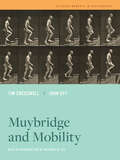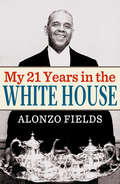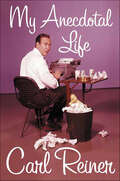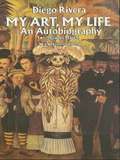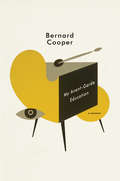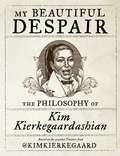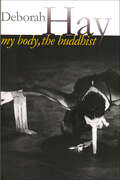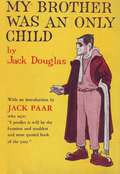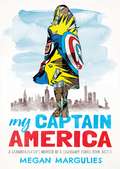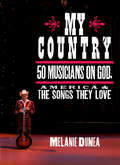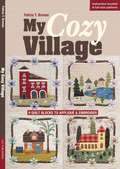- Table View
- List View
Muybridge and Mobility (Defining Moments in Photography #6)
by Tim Cresswell John OttA cultural geographer and an art historian offer fresh interpretations of Muybridge’s famous motion studies through the lenses of mobility and race. In 1878, Eadweard Muybridge successfully photographed horses in motion, proving that all four hooves leave the ground at once for a split second during full gallop. This was the beginning of Muybridge’s decades-long investigation into instantaneous photography, culminating in his masterpiece Animal Locomotion. Muybridge became one of the most influential photographers of his time, and his stop-motion technique helped pave the way for the motion-picture industry, born a short decade later. Coauthored by cultural geographer Tim Cresswell and art historian John Ott, this book reexamines the motion studies as historical forms of "mobility," in which specific forms of motion are given extraordinary significance and accrued value. Through a lively, interdisciplinary exchange, the authors explore how mobility is contextualized within the transformations of movement that marked the nineteenth century and how mobility represents the possibilities of social movement for African Americans. Together, these complementary essays look to Muybridge’s works as interventions in knowledge and experience and as opportunities to investigate larger social ramifications and possibilities.
My 21 Years in the White House
by Alonzo FieldsMy 21 Years in the White House, first published in 1960, is the fascinating account by Alonzo Fields of his service as head butler under 4 presidents: Hoover, Roosevelt, Truman, and Eisenhower. Fields (1900-1994) began his employment at the White House in 1931, and kept a journal of his meetings with the presidents and their families; he would also meet important people like Winston Churchill, Princess Elizabeth of England, Thomas Edison, John D. Rockefeller, presidential cabinet members, senators, representatives, and Supreme Court Justices. He would also witness presidential decision-making at critical times in American history -- the attack on Pearl Harbor, the death of Franklin Roosevelt, the desegregation of the military, and the outbreak of hostilities in Korea. As Fields often told his staff, “...remember that we are helping to make history. We have a small part ... but they can't do much here without us. They've got to eat, you know.” Included are sample menus prepared for visiting heads-of-state and foreign dignitaries.
My A-Z of Cricket: A personal celebration of our glorious game
by Henry BlofeldLegendary cricket broadcaster Henry Blofeld takes the reader on a journey from A-Z through the world of cricket. In his trademark charming style, Blowers goes through the alphabet, explaining some of the puzzling cricket terminology and regaling his favourite anecdotes from his fifty years in the sport. This gift book is perfect for fans of cricket who want to understand the sport from Henry's unique point of view - this is a humorous and entertaining jaunt through the cricket landscape.
My A-Z of Cricket: A personal celebration of our glorious game
by Henry BlofeldLegendary cricket broadcaster Henry Blofeld takes the reader on a journey from A-Z through the world of cricket. In his trademark charming style, Blowers goes through the alphabet, explaining some of the puzzling cricket terminology and regaling his favourite anecdotes from his fifty years in the sport. This gift book is perfect for fans of cricket who want to understand the sport from Henry's unique point of view - this is a humorous and entertaining jaunt through the cricket landscape.
My A-Z of Cricket: A personal celebration of our glorious game
by Henry BlofeldLegendary cricket broadcaster Henry Blofeld takes the reader on a journey from A-Z through the world of cricket. In his trademark charming style, Blowers goes through the alphabet, explaining some of the puzzling cricket terminology and regaling his favourite anecdotes from his fifty years in the sport, covering the most important moments in the sport's history as well as the most entertaining and amusing. The book will also contain a glossary for those who want to make sure they know their googlys from their bouncers. This gift book is perfect for fans of cricket who want to understand the sport from Henry's unique point of view, it is a humorous and entertaining jaunt through the cricket landscape.(P) 2019 Hodder & Stoughton Ltd
My Affair with Art House Cinema: Essays and Reviews
by Phillip LopatePhillip Lopate fell hard for the movies as an adolescent. As he matured into an acclaimed critic and essayist, his infatuation deepened into a lifelong passion. My Affair with Art House Cinema presents Lopate’s selected essays and reviews from the last quarter century, inviting readers to experience films he found exhilarating, tantalizing, and beguiling—and sometimes disappointing or frustrating—through his keen eyes.In an essayist’s sinuous prose style, Lopate captures the formal mastery, artistic imagination, and emotional intensity of art house essentials like Yasujirō Ozu’s Late Spring, David Lynch’s Mulholland Drive, and Andrei Tarkovsky’s Solaris, as well as works by contemporary filmmakers such as Maren Ade, Hong Sang-soo, Hou Hsiao-hsien, Christian Petzold, Paolo Sorrentino, and Jafar Panahi. Essays explore Chantal Akerman’s rigorous honesty, Ingmar Bergman’s intimacy, Abbas Kiarostami’s playfulness, Kenji Mizoguchi’s visual style, and Frederick Wiseman’s vision of the human condition. Lopate also reflects on the work of fellow critics, including Roger Ebert, Pauline Kael, and Jonathan Rosenbaum. His considered, at times contrarian critiques and celebrations will inspire readers to watch or rewatch these films. Above all, this book showcases Lopate’s passionate advocacy for not only particular films and directors but also the joys and value of a filmgoing culture.
My Anecdotal Life
by Carl ReinerOne of the most beloved figures in show business looks back on his life in short comic takes in this delightful memoir.“[Carl Reiner] has given us a veritable treasure trove of wonderful recollections, some side-splittingly funny and a few that are really touching. The best one is about me.” —Mel Brooks“You can't define genius, but it stands up and shouts from the pages of Carl Reiner’s My Anecdotal Life.” —Mary Tyler MooreIn this funny and engaging memoir, one of the best raconteurs on the planet recalls his life in show business in short comic takes. Reiner tells of how, after answering an ad for free acting classes on his brother Charlie’s advice, he forsakes a budding career as a machinist for an acting career. In “Sidney Bechet and His Jazz Band Meet Franz Kafka,” he captivates the legendary jazz man and his band with an unusual reading of The Metamorphosis, during a thunderstorm at a Catskills resort in 1942.Reiner also recalls the highlights of the succeeding decades: his first sweaty audition, impersonating a dog impersonating movie stars; his forays into the theater; his work on Your Show of Shows and The Dick Van Dyke Show during TV’s golden days; and his long friendship and collaboration with Mel Brooks which gave birth to the Two Thousand Year Old Man.In “A Recipe to Remember,” he recites a recipe for cream cheese cookies to a star-studded audience that includes Paul Newman, Leonard Bernstein, and Barbra Streisand. In “The Gourmet Eating Club,” he gives an insider’s take on the now-legendary group that included Mario Puzo, Joseph Heller, Zero Mostel, and other luminaries.Mary Tyler Moore, Sid Caesar, Mickey Rooney, Johnny Carson, Cary Grant, Dinah Shore, Ann Bancroft, Jean Renoir—the list goes on and on—also appear in what Reiner calls the “literary variety show” that captures the highs and lows of his extraordinary life. Through it all, Reiner displays the wit and warmth that have made him one of the most beloved figures in the entertainment business. This charming memoir will delight anyone who wants a behind-the-scenes look at five decades of Hollywood and television history.
My Art, My Life: An Autobiography
by Diego Rivera Gladys March"Engrossing as a novel … throws a clear white light on one of the most spectacular artists of our time." — Chicago Sunday TribuneThis remarkable autobiography began with a newspaper interview the artist gave journalist Gladys March in 1944. From then until the artist's death in 1957, she spent several months each year with Rivera, eventually filling 2,000 pages with his recollections and interpretations of his art and life. Written in the first person, this book is a richly revealing document of the painter who revolutionized modern mural painting, was a principal figure in launching the "Mexican Renaissance," and is ranked among the most influential artists of the twentieth century.As the colorful narrative unfolds, Diego Rivera seems always to be in the midst of political, artistic, and romantic turmoil. As the reviewer for The New Republic observed, "Rivera reveals a keen appreciation of this prowess in art, sex, and politics, and the record seems to be complete on the series of spectacular rows he got into over all three."The book details his bold confrontations with dictators and presidents, the battles that erupted over his murals in Rockefeller Center and the Hotel del Prado, his tempestuous marriages to Lupe Marin and artist Frida Kahlo, and much, much more. "There is no lack of exciting material. A lover at nine, a cannibal at 18, by his own account, Rivera was prodigiously productive of art and controversy." — San Francisco Chronicle. 21 halftones.
My Avant-Garde Education: A Memoir
by Bernard CooperA wry and beautifully observed memoir about coming of age in the era of conceptual art. Growing up in the suburbs--confused about his sexuality, about his consumer-oriented world, about the death of his older brother--Bernard Cooper falls in love with Pop art and sets off for the California Institute of the Arts, the center of the burgeoning field of conceptual art, in this beguiling memoir. The most famous, and infamous, artists of the time drift through the place, including Allan Kaprow and John Baldessari, not to mention the student who phones the Identi-Kit division of the Los Angeles Police Department and has them make a composite drawing of the Mona Lisa. My Avant-Garde Education is at once an artist's coming-of-age story and a personal chronicle of the era of conceptual art, from a writer "of uncommon subtlety and nuance" (David Ulin, Los Angeles Times). It is a record of the wonders and follies of a certain era in art history, always aware that awakening to art is, for a young person, inseparable from awakening to the ever-shifting nature of the self.
My Beautiful Black Hair: 101 Natural Hair Stories from the Sisterhood
by St. Clair Detrick-JulesA collection of empowering stories and captivating photos, My Beautiful Black Hair celebrates an aspect of Black femininity—natural hair—and embraces it as a central part of Black womanhood."A powerful celebration of self-acceptance and sisterhood." – Kirkus ReviewMy Beautiful Black Hair is a book about Black women embracing their natural hair. One hundred and one Black women share their stories of learning to love their natural hair and the immense power in that self-love.St. Clair Detrick-Jules was inspired to write the book when her little sister, Khloe, came home from preschool where a classmate had told her that her hair was ugly. St. Clair wanted to send a message to Khloe and young Black women everywhere that their hair is beautiful just the way it is.The stories she captured reveal both the depth of the physical and emotional damage done to many women by relaxing their hair and trying to make it look "acceptable," and the incredible resilience, self-love, and acceptance they gained by learning to embrace their hair and free themselves from Eurocentric beauty standards.Accompanied by beautiful and intimate photographs of each woman, the book is an encouraging voice for young Black women and the adults who remember their own journeys to self-acceptance.WRITTEN BY BLACK WOMEN, FOR BLACK WOMEN: With powerful interviews and vivid photographs, this book offers an uplifting message to empower any woman looking to love herself just the way she is. It is a love letter to Black women everywhere navigating their relationships to their own hair.TIMELY TOPIC: My Beautiful Black Hair celebrates Black women's ability to embrace their natural hair and let go of toxic thinking and processes around manipulating it.UNIQUE TAKE ON FEMINISM: This book offers an uplifting message to empower any woman looking to love herself just the way she is as well as a love letter to Black women everywhere navigating their relationships to their own hair.Perfect for: Black and Afro-Latinx women from their 20s to 40s, Black and Afro-Latinx parents with young children, fans of women's empowerment stories
My Beautiful Despair: The Philosophy of Kim Kierkegaardashian
by Kim Kierkegaardashian&“Reflective maxims on life, death, sin, and emptiness, salted with luxury accessories of the Kardashian lifestyle...@KimKierkegaard is dross turned gold, redemption through absurdity in a hundred and forty characters.&” –The New Yorker In &“the ultimate meeting of the sublime with the ridiculous&” (London Evening Standard) My Beautiful Despair blends the existential philosophy of Søren Kierkegaard with the superficial musings of Kim Kardashian West, based on the popular Twitter feed @KimKierkegaard. Kierkegaardashian shares thoughts on fashion, beauty, brunch, and the relentless waves of existential dread that wash over us day after day.A sample of the revelations include: – I have majorly fallen off my workout-eating plan! AND it's summer. But to despair over sin is to sink deeper into it. – Obsessed with protecting your skin, lips, hair & face from the sun? Close the cover of the coffin tight, really tight, and be at peace. – I like my men like I like my coffee: a momentary comfort in the midst of all my suffering. – What is the operation by which a self relates itself to its own self, transparently? Selfie. – What if everything in life were a misunderstanding, what if laughter were really tears? Scared LOL!! – I&’ve been going to bed a little bit earlier each night, to get a taste of death. In an age where the line between news and entertainment is blurrier than ever before, and the difference between a celebrity and the leader of the free world is nil, Kierkegaardashian&’s insights perfectly reflect our absurd, hilarious, and deeply disturbing new era. @KimKierkegaard has been admired, praised, and adored in The New Yorker, The Washington Post, The New York Times, Financial Times, The Economist, New York, Buzzfeed, and more, and has amassed nearly a quarter of a million Twitter followers, including J.K. Rowling and Anna Kendrick. Now in a humorous, illustrated gift book, perfectly suited for our existential times, Kierkegaardashian&’s philosophical insights are juxtaposed for the first time with Dash Shaw&’s brilliant black-and-white illustrations.
My Beautiful Struggle
by Jordan BoneA girl with her whole life ahead of her. A terrible accident. An inspiring story of triumph over trauma. Aged 15, Jordan was a happy-go-lucky girl; having fun with friends and loving life. In one fateful moment, everything changed. A car accident left her paralysed from the chest down and shocked her into deep depression. She was on the brink of giving up. But gradually Jordan realised there is hope beyond utter devastation, and life beyond disability.Painstakingly re-learning how to apply her beloved make-up, Jordan began to rebuild her sense of self and empowerment. Her body may have been broken but her spirit was not. She is now a successful beauty blogger and her journey of positivity inspires millions around the world.MY BEAUTIFUL STRUGGLE is the incredible true story of how one young woman overcame immense challenges, of inner strength that lies beneath outer beauty, of how to believe in yourself and find the light when it feels like all hope is gone.
My Beautiful Struggle
by Jordan Bone<P>Aged 15, Jordan Bone got into a car with friends. She would never walk again. Paralysed from the chest down, her life was changed forever. Becoming depressed and feeling like life wasn't worth living, these weren't the teenage years that Jordan had envisaged. <P>However, slowly but surely, she began to get herself out of the darkness. With a little help from the internet, Jordan started to embrace positive thinking and embarked on a personal journey to get her confidence - and her life - back. Eleven years on from the accident, Jordan creates her own beauty tutorials on YouTube and has a range of successful brand partnerships. She has reclaimed her life and her independence and now wants to share her inspirational story with others and is telling it through different aspects of beauty. This isn't a book about looking good on the surface, this is a story of inner strength, believing in yourself and finding motivation when you feel like all hope is gone.
My Body, The Buddhist
by Deborah HayThrough a series of imaginative approaches to movement and performance, choreographer Deborah Hay presents a profound reflection on the ephemeral nature of the self and the body as the locus of artistic consciousness. Using the same uniquely playful poetics of her revolutionary choreography, she delivers one of the most revealing accounts of what art creation entails and the ways in which the body, the center of our aesthetic knowledge of the world, can be regarded as our most informed teacher. My Body, The Buddhist becomes a way into Hay's choreographic techniques, a gloss on her philosophy of the body (which shares much with Buddhism), and an extraordinary artist's primer. The book is composed of nineteen short chapters ("my body likes to rest," "my body finds energy in surrender," "my body is bored by answers"), each an example of what Susan Foster calls Hay's "daily attentiveness to the body's articulateness."
My Bright Abyss: Meditation Of A Modern Believer
by Christian WimanSeven years ago, Christian Wiman, a well-known poet and the editor of Poetry magazine, wrote a now-famous essay about having faith in the face of death. My Bright Abyss, composed in the difficult years since and completed in the wake of a bone marrow transplant, is a moving meditation on what a viable contemporary faith—responsive not only to modern thought and science but also to religious tradition—might look like. Joyful, sorrowful, and beautifully written, My Bright Abyss is destined to become a spiritual classic, useful not only to believers but to anyone whose experience of life and art seems at times to overbrim its boundaries. How do we answer this “burn of being”? Wiman asks. What might it mean for our lives—and for our deaths—if we acknowledge the “insistent, persistent ghost” that some of us call God? One of Publishers Weekly's Best Religion Books of 2013.
My Broken Language: A Memoir
by Quiara Alegría HudesA Pulitzer Prize–winning playwright tells her lyrical story of coming of age against the backdrop of an ailing Philadelphia barrio, with her sprawling Puerto Rican family as a collective muse. &“Quiara Alegría Hudes is in her own league. Her sentences will take your breath away. How lucky we are to have her telling our stories.&”—Lin-Manuel Miranda, award-winning creator of Hamilton Quiara Alegría Hudes was the sharp-eyed girl on the stairs while her family danced in her grandmother&’s tight North Philly kitchen. She was awed by her aunts and uncles and cousins, but haunted by the secrets of the family and the unspoken, untold stories of the barrio—even as she tried to find her own voice in the sea of language around her, written and spoken, English and Spanish, bodies and books, Western art and sacred altars. Her family became her private pantheon, a gathering circle of powerful orisha-like women with tragic real-world wounds, and she vowed to tell their stories—but first she&’d have to get off the stairs and join the dance. She&’d have to find her language. Weaving together Hudes&’s love of books with the stories of her family, the lessons of North Philly with those of Yale, this is an inspired exploration of home, memory, and belonging—narrated by an obsessed girl who fought to become an artist so she could capture the world she loved in all its wild and delicate beauty.
My Brother Was An Only Child
by Jack Douglas Jack Paar"My Brother Was an Only Child" was Jack Douglas' very first humour book, having written for famous radio and television celebrities such as Jack Paar, Bob Hope, Bing Crosby and Jimmy Durante, as well as TV shows such as "Adventures of Harriet and Ozzie", "The George Gobel Show", and "Laugh-In". It perfectly captures the sense of humour prevalent in this era and is as refreshing and side-splittingly funny now as it was then.
My Captain America: A Granddaughter's Memoir of a Legendary Comic Book Artist
by Megan MarguliesA finely wrought coming-of-age memoir about the author&’s relationship with her beloved grandfather Joe Simon, cartoonist and co-creator of Captain America.In the 1990s, Megan Margulies&’s Upper West Side neighborhood was marked by addicts shooting up in subway stations, frequent burglaries, and the &“Wild Man of 96th Street,&” who set fires under cars and heaved rocks through stained glass church windows. The world inside her parents&’ tiny one-bedroom apartment was hardly a respite, with a family of five—including some loud personalities—eventually occupying the 550-square-foot space. Salvation arrived in the form of her spirited grandfather, Daddy Joe, whose midtown studio became a second home to Megan. There, he listened to her woes, fed her Hungry Man frozen dinners, and simply let her be. His living room may have been dominated by the drawing table, notes, and doodles that marked him as Joe Simon the cartoonist. But for Megan, he was always Daddy Joe: an escape from her increasingly hectic home, a nonjudgmental voice whose sense of humor was as dry as his farfel, and a steady presence in a world that felt off balance. Evoking New York City both in the 1980s and &’90s and during the Golden Age of comics in the 1930s and &’40s, My Captain America flashes back from Megan&’s story to chart the life and career of Rochester-native Joe Simon, from his early days retouching publicity photos and doing spot art for magazines, to his partnership with Jack Kirby at Timely Comics (the forerunner of Marvel Comics), which resulted in the creation of beloved characters like Captain America, the Boy Commandos, and Fighting American. My Captain America offers a tender and sharply observed account of Megan&’s life with Daddy Joe—and an intimate portrait of the creative genius who gave us one of the most enduring superheroes of all time.
My Circus
by Xavier DeneuxAnother squeezably soft feast for the senses. Xavier Deneux turns another simple concept book into high art--this time treating readers to the wonders of the circus. Perfect for babies and toddlers, My Circus introduces clowns, magicians, trapeze artists, and many more familiar stars of the big top.
My Couch is Your Couch
by Gabriele GalimbertiTour the world from inside other people's homes Documentarian and photographer Gabriele Galimberti traveled the world for more than two years. He stayed only with members of the diverse, multicultural Couchsurfing.com community, the social network website that connects travelers with hosts across the globe. The stunning photography collection in My Couch Is Your Couch reveals the wide range of spaces we can call "home." Sleeping everywhere, from a castle-like estate in Germany surrounded by a moat to a hut in Fiji made of metal sheeting, from the recording studio and flat of an indie band in London to a cube-shaped cement home in rural Morocco adorned only with Berber carpets, Gabriele saw the world and its cultures from the inside. Across six continents, he photographed his hosts at home, at work, and at play, and in doing so, captured the essence of each person and place. My Couch Is Your Couch is about sharing and learning; it presents moments of awkwardness and discomfort, friendship, and sometimes even love. Ultimately, Gabriele reveals what's at the center of travel: connecting with other people.
My Country: 50 Musicians on God, America & the Songs They Love
by Melanie DuneaNow in paperback, a volume of stunning photographs of 50 country music icons and intimate accounts of their thoughts on God, America, and their favorite songs.Award-winning photographer and author of My Last Supper, Melanie Dunea traces the throughlines from country music's gritty roots to the chart-topping chanteuses of today, presenting beautiful, imaginative, and revealing photographs of icons ranging from Taylor Swift to Wynnona Judd to Little Jimmy Dickens and conducting interviews that ask stars to discuss their musical roots and inspirations, their defining moments, and what makes country music the heart and soul of America.As the music industry fractures and suffers from flagging sales, country music has enjoyed explosive growth and unprecedented popularity. This totally unique book will be a must-own (and a perfect gift) for fans of the old time country twang and the millions who love the glitz and glamour of today's country-pop. My Country is a music-lovers dream, and in this more inexpensive, accessible market the book is sure to find its core audience amongst country music's legions of fans.
My Cozy Village: 9 Quilt Blocks to Appliqué & Embroider
by Felicia T. BrenoeCreate an inviting little world bustling with life on a quilt or wallhanging!From a charming church to a country cabin, and the town hall to the fire station, nine full-size appliqué patterns and borders come together to make a full-size quilt as warm as a welcome or a four-block wallhanging that conveys a rich sense of community. Personalize your village with embroidery and choose from two colorways to make it your own. Learn appliqué techniques and pick your favorite method?hand or machine appliqué?to get sewing right away!
My Creative Space: How to Design Your Home to Stimulate Ideas and Spark Innovation
by Donald M. Rattner48 Techniques to Boost Your Creativity at Home, According to Science A great deal of psychological and productivity research has gone into discovering how the design of the physical environment can improve creative performance, yet nearly all of it has focused on the workplace, commercial spaces, and schools. What has been largely overlooked is the one place we spend more time in than anywhere else and where more people than ever are now working: the home. My Creative Space shows how readers can boost their creative output by applying science-backed techniques to the design and decoration of their home regardless of size, type, style, or location. With over 200 stunning color photographs of creative spaces, including many designed by top architects and interior decorators, this lavishly produced book will inspire readers while offering practical and specific ways to transform your own home into a creative haven. Readers will: Learn practical techniques to shape a home for peak idea generationAcquire insights into how everyday activities at home can boost creative performance at work, play, and schoolDiscover hands-on household products designed to foster creative skillsGain a new understanding of the meaning and psychology of creativity Read about the best lighting to foster a creative environment, how to use walls to capture ideas, why round shapes spur greater creativity than straight lines, the benefits of incorporating nature into your surroundings, and more. Whether you're an artist, design professional, writer, entrepreneur, work in a creative industry, or pursue a personal passion for pleasure, this book is an invaluable guide for turning living space into creative space.
My Crochet Animals: Crochet 12 Furry Animal Friends plus 35 Stylish Clothes and Accessories
by Isabelle KessedjianMake cute, creative creatures from farmyard and forest—and dress them up for gifts that will delight friends and family! Instagram doyenne Isabelle Kessadjian, the hottest name in crochet, brings you adorable animals to crochet in this fabulous new collection of twelve cheeky characters. From foxes in the forest to perky pigs in the farmyard, all of these animals come with their very own stylish wardrobe and mini accessories. Isabelle's easy to follow patterns show you how to crochet each animal friend, and then you can choose how you want to clothe and accessorize. Each animal is presented as a mini story to bring your new friend to life—so why not go on a day out with Family Rabbit and their baby Bunny, take a romantic trip to Paris with Koala and Panda, have fun on a camping trip with Bear complete with satchel and camera, explore the forest with Reindeer and Fox, and enjoy a feast with the pink and perky Pigs?
My Crochet Doll: A Fabulous Crochet Doll Pattern with Over 50 Cute Crochet Doll Clothes and Accessories
by Isabelle KessdjianInstagram sensation Isabelle Kessedjian has created this adorable doll and amazing wardrobe in crochet! Designs include a wide range of outfits, from school days and bedtime to cute fancy dress costumes and adventures to the North Pole! Discover how to crochet your doll and then personalize her with your choice of hair, clothing and accessories. She even has a cute suitcase to store all of her belongings, which can also double up as a bed!Be aware that crochet terms in the US are different from those in the UK. This can be confusing as the same terms are used to refer to different stitches under each system. All crochet patterns in this book are written in UK and European terms. US crocheters must take care that they work the correct stitches. One way to tell which system is being used in other patterns is that the American system starts with a single crochet, which the UK system doesn't have; so patterns with 'sc' in them can be identified as American patterns.
